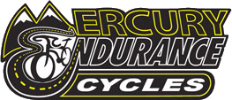Bike Fitting Details
Fresh out of the Specialized’s fit school, Jamie Boward, owner of Mercury Endurance Cycles, is now offering Specialized Body Geometry (BG) Bike Fits. Having just been fitted in September, my bike fit has been solid. So instead, Liz agreed to be the guinea pig. With a new bike, it was critical for Liz to be fitted.
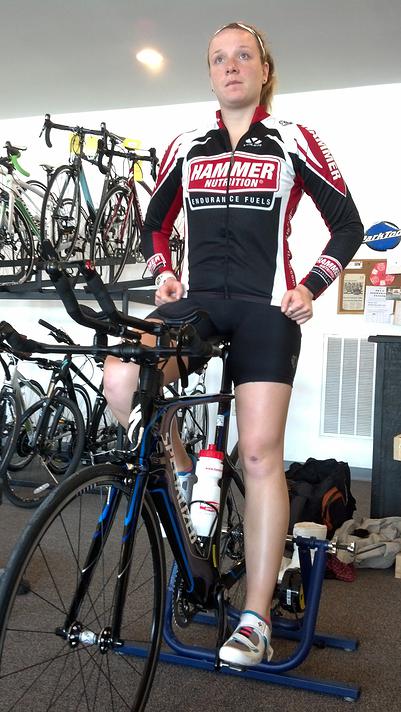
Why? Getting into to the right position will:
- Reduce likelihood of injury
- Increase power, speed, and efficiency
- Ensure comfort
- Improve handling and control
To make your appointment, give Jamie a call, (240) 347-4959.
Before we get into the review, let me mention this. Get fitted early in your season to get the maximum benefit. Still, it is never too late for a fit. I will also stress that you should be fitted every year, because things change. Your flexibility changes, your goals change, and even the types of races you compete in change. Definitely get a fit if you buy a new bike.
Lastly, what do you need to bring?
- Bike
- Bike shoes
- And wear your usual cycling clothes
Now let’s get into the fit process. The BG fit takes about 2-3 hours. Just like going in for a car inspection, any issues that crop up will add time to the fit. Generally, being fit to a triathlon bike is a bit more difficult since the position is aggressive and will require extra attention.
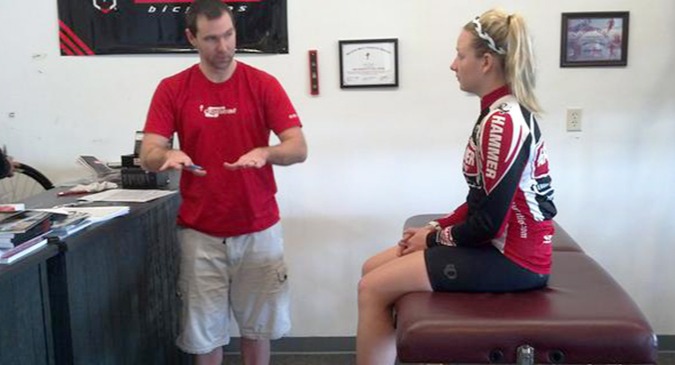
Pre-Fit Interview
The first part of the fit is an interview. Jamie went over Liz’s cycling history and asked about any injuries. He also asked how much riding she does and her goals. This quick interview gave Jamie an idea of not only any issues he should watch for (e.g., knee, hip, or back injury), but how aggressive of a fit he should set her up with. To you give you an idea, Jamie will stress comfort for an Ironman athlete who will spend 6-7 hours in the saddle while a short-course triathlete can hold a more aggressive, aerodynamic position. The same goes for the position between a beginner and experienced athlete.
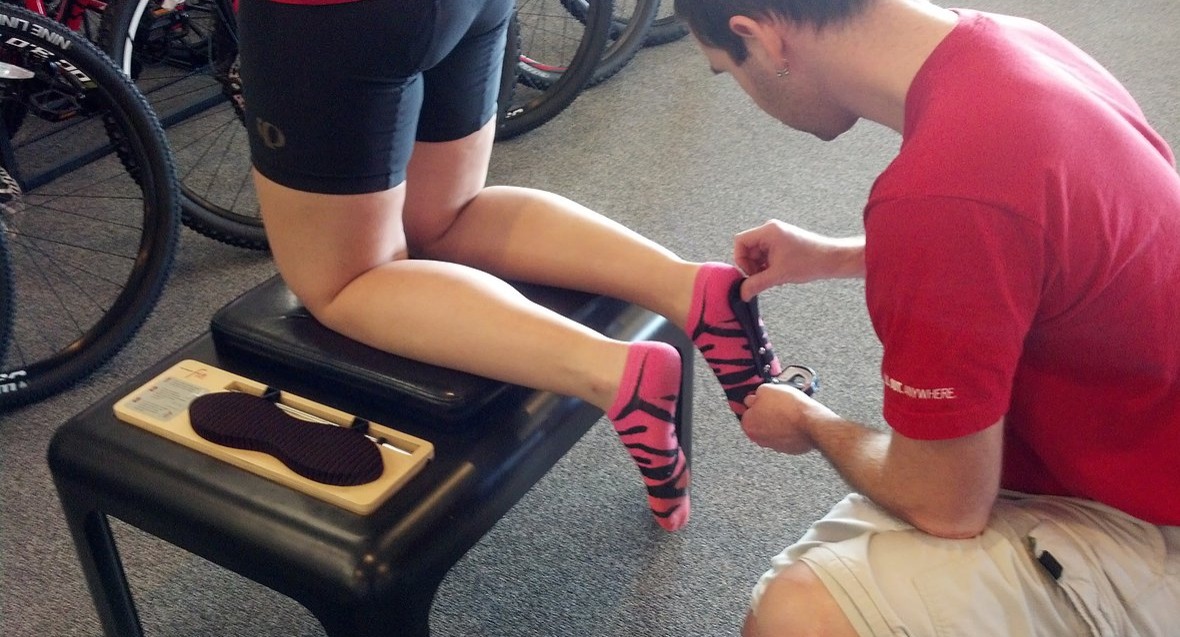
Pre-Fit Assessment
Next, Jamie performed a Pre-Fit Assessment which evaluates an athlete’s flexibility, strength, and anatomical discrepancies.
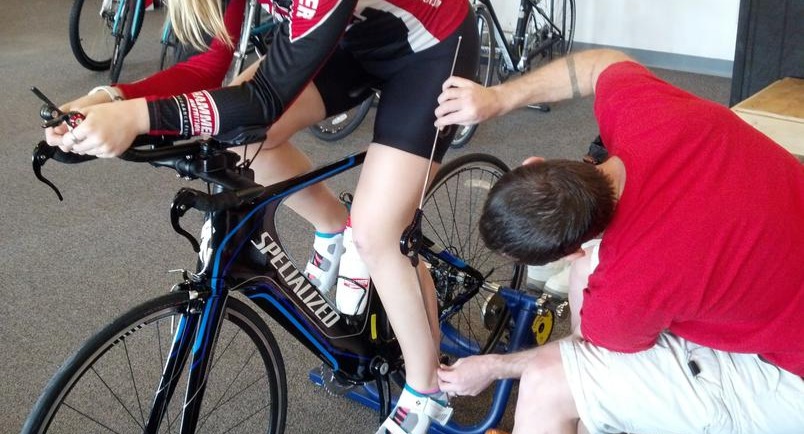
Side-View Analysis
Jamie started the Side-View Analysis, and Liz finally got to ride. Here, Jamie assessed Liz’s alignment and body angles on the bike. His goal was to establish a powerful and comfortable position by adjusting the seat height, seat fore and aft position, and cleat position.
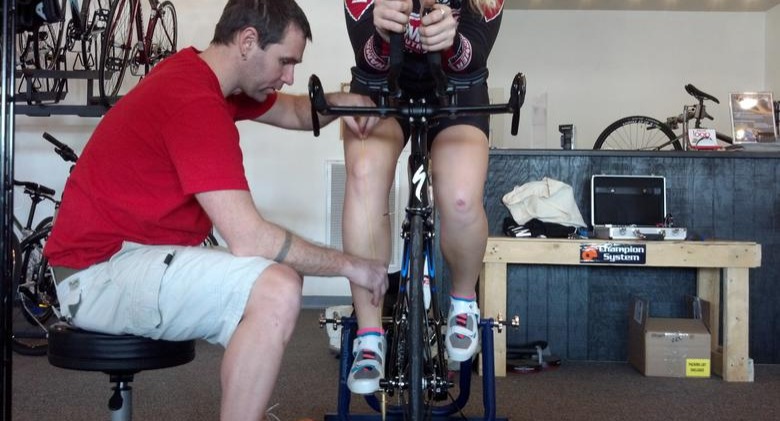
Front-View Analysis
From the front view, Jamie noticed a misalignment. Specifically, how Liz’s knee does not track straight up and down. This is caused by Liz’s forefoot angulation. There are three types of forefoot angulation:
Varus angulation
When pedaling, the knee rotates inward towards the bike’s top tube when the athlete is at the top of their stroke. This is caused by the inside of the forefoot being significantly higher than the outside. This occurs in roughly 85% of people.
Valgus angulation
When pedaling, the knee rotates outward away from the bike’s top tube when the athlete is at the top of their stroke. This is due to the outside of the forefoot being higher than the inside. This is far less common only occurring for about 5% of people.
Neutral foot
The knee tracks straight up and down. This occurs in 10% of people.
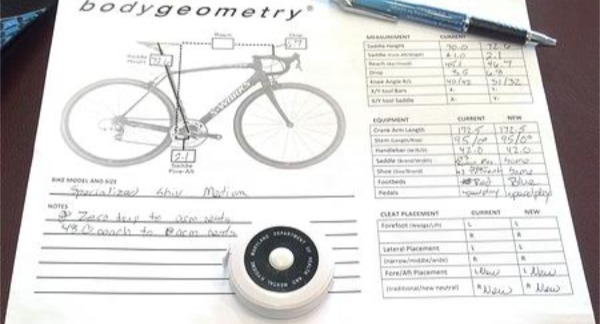
Follow-Up
Finally, Jamie recorded the bike’s measurements. This is very helpful if you need to disassemble the bike and you forget to mark your component’s positions. It may take a few rides for an athlete to settle into the new fit. However if you feel any pain or discomfort, let Jamie know so he can fix any issues.
Comparison to Other Bike Fits
Advantages
Other bike fits place you on a bike fitting machine. The idea is the fitter can transcribe the measurements from the bike fitting machine to your bike. However, this extra step is another opportunity for error. I’ll discuss bike fitting machines further in the following advantages and disadvantages.
1. Good for fitting you to your current bike
There is never a bad time to get a proper fit on your bike.
2. Professional and certified fitter
I mention this aspect since the first bike fit I ever received was from a non-certified fitter. The guy knew the basic principles. Still, the fit was not as prescriptive as the BG fit. Certified BG fitters endure a week long training course and require continuing education credits to maintain their certification.
3. No downtime without your bike
There is no need to drop your bike off, and once the fit is complete, you can walk right out the door with your bike. This can be an issue for other fit systems.
4. Inexpensive compared to other bike fits
Mercury offers this extensive Specialized bike fit $50-100 less than competitors.
Disadvantages
1. The actual fit process takes time
The benefit of being fitted on a bike fit machine is the fitter can make adjustments on the fly. This makes the fit process quicker and easier. While eventually you will find your perfect fit during a BG fit, an adjustment takes longer to make because our bikes were not made to be adjusted quickly. The athlete needs to dismount the bike, the fitter pulls out his wrench, loosens a few bolts, makes the adjustment, tightens the bolts, the athlete mounts the bike, and the new position is measured.
2. Not ideal at finding a new bike that would fit you
Other bike fits that use a bike fitting machine provide you a frame stack and reach measurements. These measurements are unique to you and can be used to find your perfect bike. Slowtwitch.com offers a database that lists a majority of bike manufacture’s frame stack and reach measurements for each of their models. While these measurements can be taken off your current bike once you are fitted, you will need a bike to begin with to be fitted.
3. BG Fit is a static fit (versus a dynamic fit)
A static fit is performed by having the athlete pedal consistently then stop at a specific position to take a measurement. Ideally, the fitter will notice the little nuances of an athlete’s motion while pedaling and attempt to replicate them at the resting position (e.g., if the athlete’s toe is pointed downward severely while pedaling, the fitter will ensure the athlete’s toe is pointed at the resting position).
A dynamic fit uses the latest and greatest technology to capture the rider’s position in motion. For example, Retül uses a camera and LED markers to capture a rider’s motion. The Retül software then produces a stick figure of the athlete and determines the rider’s different body angles in a matter of seconds. But of course, an advanced technology comes at a greater price tag.
